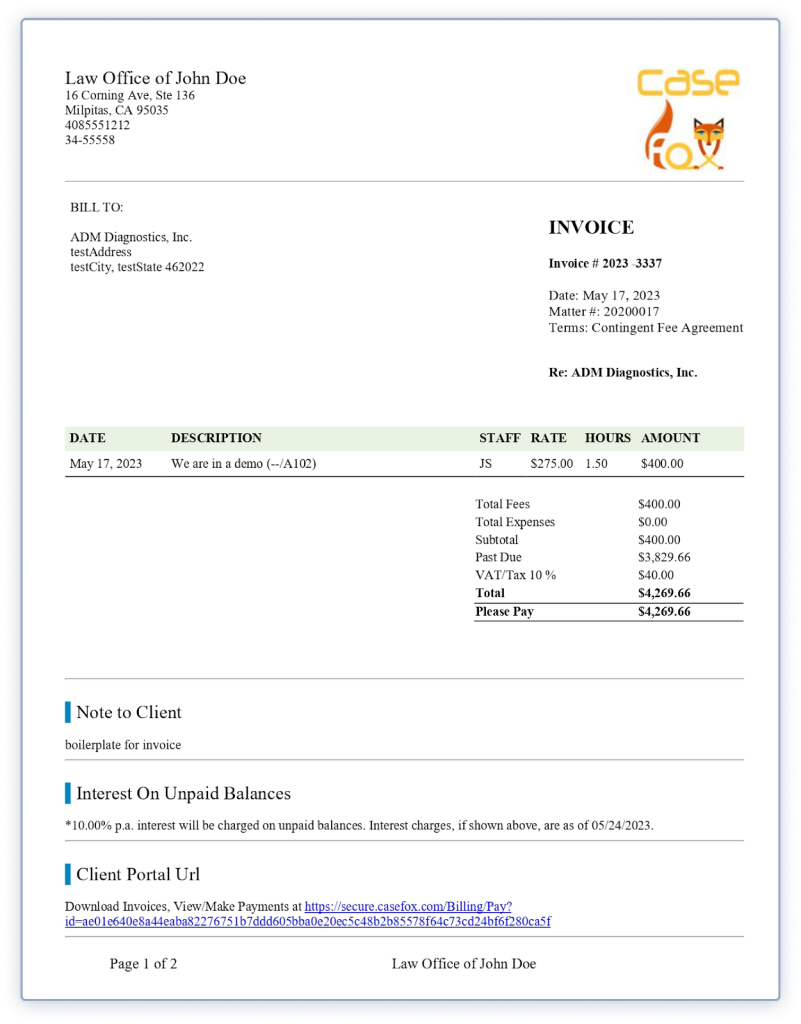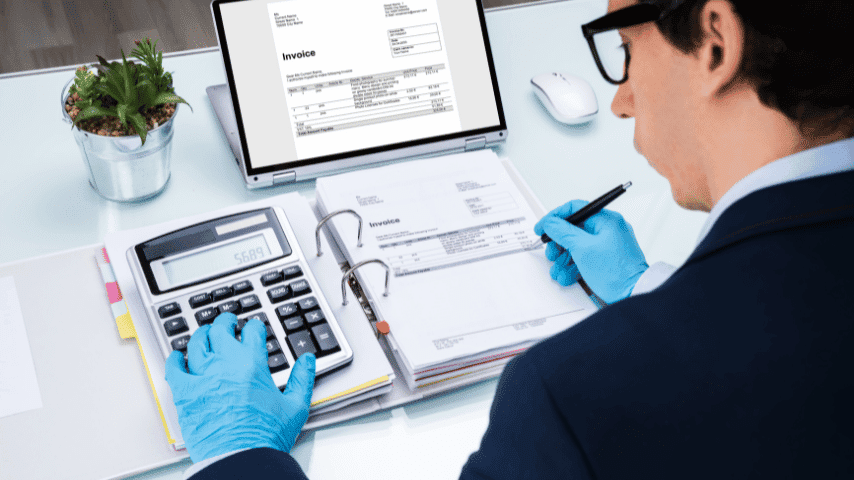[intake_form]
In the legal profession, accurate and transparent billing is crucial for maintaining client trust and ensuring fair compensation for services rendered. One essential tool in this process is the attorney billing statement. In this blog post, we will guide you through the process of creating a well-crafted billing statement. From understanding its components to providing practical tips and a sample for reference, we have got you covered.
Understanding the Components of an Attorney Billing Statement:
To create an effective billing statement, it’s important to understand its components. Let’s break down each element:
- Client Information: Begin by including essential details about the client, such as their name, contact information, and billing address. This information ensures accurate identification and facilitates easy communication.
- Matter Details: Specify the matter or case name, number, and any relevant reference information. This helps clients associate the charges with the specific legal matter.
- Time and Expense Entries: Provide a detailed breakdown of the time spent on the matter, including the date, activity description, and hours worked. For expenses, itemize each cost incurred, such as filing fees or research expenses. Accurate timekeeping and expense tracking are crucial for transparency.
- Fee Structure and Rates: Clearly outline the fee structure, whether it’s based on an hourly rate, a flat fee, or a contingency arrangement. State the agreed-upon rates for each service provided to avoid confusion.
- Summary of Charges: Summarize the total charges for the billing period, including both time and expense entries. Present the information in a clear and organized manner to facilitate client understanding.
- Payment Instructions: Include instructions on how clients can make payments, whether it’s by check, credit card, or electronic transfer. Specify the due date and any applicable late payment penalties or discounts for early payment.
Tips for Creating an Effective Attorney Billing Statement:
Crafting an attorney billing statement that is clear, concise, and informative is essential. Here are some practical tips to consider:
- Use Clear and Concise Language: Avoid legal jargon and use language that is easily understood by clients. Clearly explain each charge and provide sufficient detail to justify the billing.
- Ensure Accurate Timekeeping and Expense Tracking: Implement a reliable system to track your time and expenses. Accurate records not only help with creating billing statements but also serve as supporting documentation in case of disputes.
- Maintain Consistent Formatting and Structure: Establish a consistent layout and format for your billing statements. This ensures professionalism and makes it easier for clients to navigate the document.
- Incorporate Descriptive Narratives: Accompany time entries with brief, descriptive narratives to provide context and clarity. Clients appreciate knowing the specific tasks performed and the progress made on their case.
- Provide Transparency and Detail: Be transparent about how charges are calculated and include itemized expenses. Clients should have a clear understanding of the value they are receiving for the services rendered.
- Proofread and Review for Accuracy: Double-check all entries and calculations before finalizing the billing statement. Errors can erode client trust and lead to payment delays or disputes.
Sample Attorney Billing Statement:
To help you visualize a well-constructed billing statement, here is a sample attorney billing statement:

Utilizing Billing Software for Streamlined Processes:
Billing software can significantly streamline the billing process, saving you time and effort. Consider the following benefits of automated billing systems:
- Time Savings: Automated software eliminates the need for manual calculations and formatting, allowing you to generate billing statements quickly.
- Accuracy and Consistency: Billing software reduces the risk of errors and ensures consistency in formatting and structure across all billing statements.
- Expense Tracking: Some billing software enables easy tracking and categorization of expenses, making it convenient to include them in the billing statement.
- Reporting and Analysis: Advanced software provides comprehensive reporting and analysis features, allowing you to gain insights into your practice’s financial performance.
Research and select billing software that aligns with your practice’s specific needs. Look for features such as user-friendly interfaces, customizable templates, integration with accounting systems, and secure data storage.
How to Generate Perfectly Curated Invoices Through Billing Template
Preparing an attorney billing statement using a billing template can save you time and ensure consistency in your billing practices. Here’s a step-by-step guide to help you through the process:
Select a Billing Template:
Choose a billing template that suits your practice’s needs. Look for templates specifically designed for attorneys or legal professionals, as they often include relevant sections and fields.
- Customize the Template:
Open the billing template in your preferred software (e.g., Microsoft Word, Excel, or specialized billing software). Customize the template to include your firm’s name, logo, and contact information. Ensure that the template reflects your branding and presents a professional image.
- Input Client Information:
Begin by entering the client’s information, including their name, address, contact details, and any relevant identification numbers (such as a client or matter number). This information should be prominently displayed at the top of the billing statement.
- Provide Matter Details:
Specify the matter or case name, number, and any relevant reference information to help clients associate the charges with the specific legal matter. This assists in organizing and categorizing your billing statements.
- Include Time and Expense Entries:
Use the template’s designated sections or tables to enter time and expense entries. Include columns for the date, description of the task or expense, hours spent, rate, and amount. You can also categorize entries by activity type or phase of the matter for easier tracking and analysis.
- Specify Fee Structure and Rates:
Clearly outline your fee structure and rates for each service provided. Indicate whether it’s based on an hourly rate, flat fee, or contingency arrangement. Include the agreed-upon rates for different types of work, such as research, client meetings, court appearances, and document drafting.
- Summarize Charges:
Provide a summary of charges for the billing period, including both time and expense entries. This section should present a clear and concise overview of the total amount owed by the client.
- Payment Instructions:
Include clear instructions on how clients can make payments, such as by check, credit card, or electronic transfer. Specify the due date and any applicable late payment penalties or discounts for early payment. This section should guide clients on how to fulfill their payment obligations promptly.
- Review and Proofread:
Thoroughly review the billing statement before finalizing it. Check for any typos, incorrect calculations, or missing information. Ensure that all the sections and entries are accurate, consistent, and aligned with your billing practices.
- Save and Distribute:
Save the completed billing statement in the appropriate file format (e.g., PDF or Word document). Distribute the billing statement to the client according to your preferred method, such as email or postal mail. Make sure to securely store a copy for your records.
Remember, each billing template may have unique features and customization options. Adapt the steps above to fit the specific template you are using.
Using a billing template can streamline your billing process and ensure professionalism in your attorney billing statements. Regularly review and update your template as needed to accommodate changes in your billing practices or to meet client expectations.
Best Practices for Billing Statement Delivery:
Delivering your billing statements effectively is just as important as creating them. Consider the following best practices:
- Choosing the Right Delivery Method: Determine the most convenient and secure method for sending billing statements to clients. Options may include email, traditional mail, or secure online portals.
- Ensuring Confidentiality and Security: Safeguard client information and billing statements by utilizing secure file transfer methods or encrypted email systems.
- Timely and Regular Billing Cycle: Establish a regular billing cycle to maintain consistency and predictability for both you and your clients. Consistent billing reduces the chances of delayed payments or missed invoices.
- Addressing Client Concerns and Queries: Occasionally, clients may have concerns or questions regarding billing statements. To handle these situations effectively:
- Dealing with Billing Disputes: Maintain open lines of communication and address any concerns promptly and professionally. Listen to your clients’ perspectives and work towards a mutually satisfactory resolution.
- Effective Communication and Resolution: Clearly explain any charges or discrepancies, provide additional documentation if necessary, and be open to discussing payment arrangements if needed. Focus on maintaining a positive client relationship throughout the resolution process.
Creating an attorney billing statement that is accurate, transparent, and professionally presented is essential for any legal practice. By following the tips mentioned in this blog post and utilizing the sample provided, you will be well-equipped to master the art of creating effective billing statements. By doing so, you will enhance client satisfaction, maintain financial integrity, and foster strong client relationships in your legal career. Embrace the power of clear communication and transparency to ensure a seamless billing process for both you and your clients.

